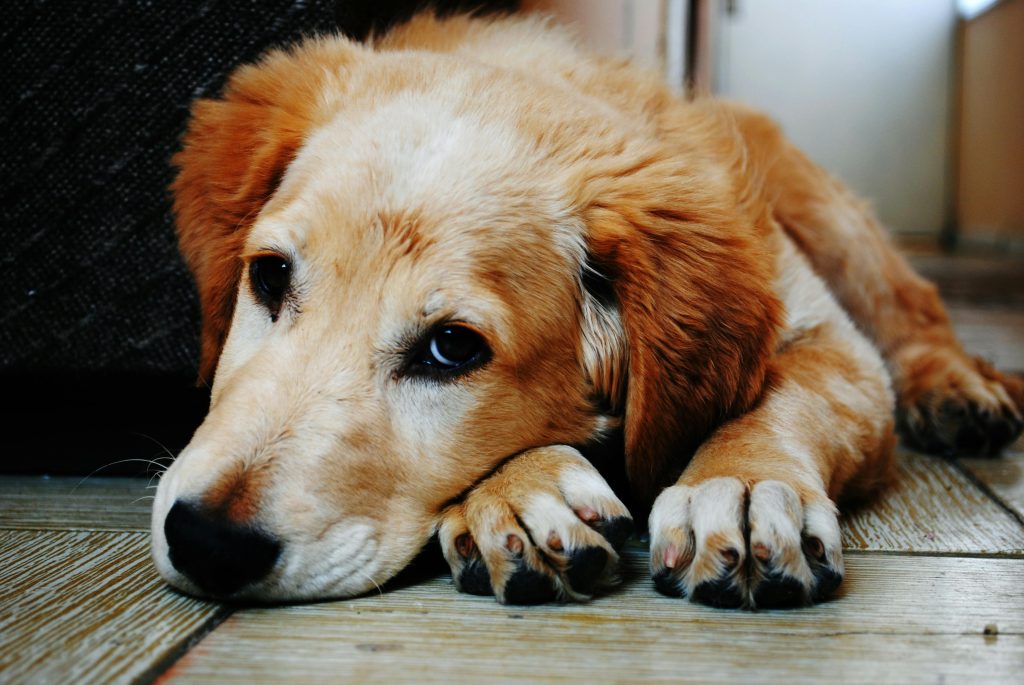Before bringing Sunny home, I had read a ton of articles and guides. But as they say, theory is one thing—real life is another. Once the dog is actually in your home, you’ll realize just how many unexpected problems come up!
The first challenge? Putting Sunny in the crate.
She whimpered and cried nonstop, and it absolutely tore at my heart.
I thought, Maybe I should just let her out and play with her for a while?
Sunny was thrilled. She played happily and showed no signs of fear—completely at ease with her new environment.
Just when we thought we were getting through the newbie phase smoothly, trouble hit:
Sunny started showing signs of stress—she refused to eat!
Aside from sipping a bit of water now and then, she wouldn’t touch anything—not the goat milk, not even her soaked kibble.
By the second day, things got worse. She just lay in the crate listlessly, with zero energy or alertness.
And really, how could she feel okay without eating?

Then came the scariest moment—she started foaming at the mouth.
It totally freaked us out.
We rushed her to the vet and ended up spending several hundred dollars.
The poor puppy suffered, we were mentally and physically exhausted, and our wallets? Completely drained.
I believe a lot of first-time dog parents go through the exact same thing:
You bring the dog home, and suddenly you realize—you have no idea what you’re supposed to do next.
Then it becomes a frantic cycle of Googling everything—
Can I do this? Is that okay? Should I try that?
Now that I’ve been through it myself, I’ve put together a comprehensive list of do’s and don’ts for bringing a new puppy home. I hope this can be a helpful guide for fellow first-time dog owners.
🐶 1. Create a Sense of Security
-
Provide a quiet, cozy corner or crate, lined with soft bedding or your worn clothing.
-
In the early days, limit your puppy’s roaming space to reduce stress and avoid sensory overload.
🚿 2. Avoid Bathing Too Soon
-
Do not bathe your puppy before vaccinations are complete.
-
Typically, dogs need 3 rounds of vaccines + 15 days of observation.
-
You can use dry shampoo foam or a damp towel for gentle spot-cleaning.
-
Puppies have fragile immune systems—early baths can lead to colds or serious illnesses like canine distemper or parvovirus.
💉 3. Vaccination & Deworming
-
Deworm your puppy one week after arriving home. Internal and external deworming should be spaced a few days apart.
(Note: Internal deworming may temporarily affect appetite. Always follow dosage instructions carefully.)
-
Begin vaccinations after two weeks, only if your puppy is in good health.
-
Avoid outdoor walks, public spaces, or contact with other animals before vaccines are completed.
🩺 4. Health Monitoring
-
Keep an eye on your puppy’s energy level, nose moisture (a wet nose indicates good health), and stool consistency (should be well-formed).
-
If your puppy shows signs of loss of appetite, diarrhea, or vomiting, consult an experienced pet owner or a vet—do not self-medicate.
-
To ease the transition, bring items with familiar scents—like old toys or blankets from the previous environment.
(I got Sunny from a private seller and was able to get items she had used before.)
🛑 5. Minimize Stimulation
-
On the first day home, avoid over-interacting. Let the puppy rest adequately (pups sleep about 16 hours a day).
-
If the puppy cries at night, you can cover the crate with a dark cloth or lightly tap it to stop the behavior.
Avoid immediate comfort responses that might unintentionally reinforce whining.
🍽️ 6. Feed Properly and Scientifically
-
Offer small meals multiple times a day (typically 4 times).
-
Kibble should be soaked in warm water until soft (especially for pups under 3 months old).
-
Stick with the original food from the breeder for at least a week.
-
If switching food, do a 7-day gradual transition, replacing the old food bit by bit.
🚫 7. Forbidden Foods
(See our full guide on toxic foods for dogs.)
-
Avoid cow’s milk (most dogs are lactose intolerant), salty or sugary human foods, chocolate, onions, and other toxic items.
-
You can supplement with goat milk powder, probiotics for digestion, and boiled egg yolk for a shinier coat.
🧻 8. Potty Training
-
After meals or naps, guide your puppy to the pee pad area.
-
Reinforce scent memory by placing used pads in the same spot.
-
If the puppy has an accident, never scold or punish—this might cause them to hold it in out of fear.
-
Clean up with odor eliminator spray to remove lingering smells.
Correct potty? Praise right away and offer a small toy or treat as a reward!
🐕 9. Behavior Training
-
The 3–4 month stage is a golden window for basic obedience training.
-
Use healthy treats (like freeze-dried duck cubes) to reinforce good behavior.
-
Avoid excessive pampering—failure to correct bad habits early on may lead to long-term behavior issues.
-
Establish clear boundaries and command responsiveness from day one. It’s crucial!
🛡️ 10. Other Must-Know Safety Tips
-
Keep warm: Puppies can’t regulate body temperature well.
Avoid letting them sleep on cold floors or directly under air conditioning.
In winter, make sure their bed is warm and draft-free. -
Puppy-proof your space:
Keep trash cans, medications, and exposed electrical cords out of reach to prevent chewing, choking, or electrocution. -
Socialization:
After completing vaccinations, gradually introduce your puppy to the outside world.
Start by going out during quiet times in less crowded places to help them adapt.
Bringing a puppy home comes with lots of responsibilities. But if you’re well-prepared, the whole experience will be much smoother and more rewarding.
For all new dog parents out there—do your homework, and your pup will thank you for it 🐾

